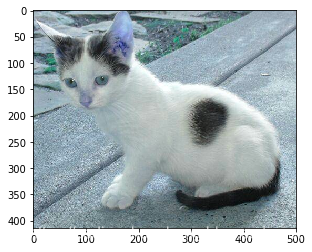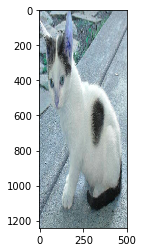cv2.IMREAD_COLOR:彩色图像
cv2.IMREAD_GRAYSCALE:灰度图像
import cv2
import matplotlib. pyplot as plt
import numpy as np
% matplotlib inline
img = cv2. imread( "cat.jpg" )
img
array([[[142, 151, 160],
[146, 155, 164],
[151, 160, 170],
...,
[156, 172, 185],
[155, 171, 184],
[154, 170, 183]],
[[108, 117, 126],
[112, 123, 131],
[118, 127, 137],
...,
[155, 171, 184],
[154, 170, 183],
[153, 169, 182]],
[[108, 119, 127],
[110, 123, 131],
[118, 128, 138],
...,
[156, 169, 183],
[155, 168, 182],
[154, 167, 181]],
...,
[[162, 186, 198],
[157, 181, 193],
[142, 166, 178],
...,
[181, 204, 206],
[170, 193, 195],
[149, 172, 174]],
[[140, 164, 176],
[147, 171, 183],
[139, 163, 175],
...,
[169, 187, 188],
[125, 143, 144],
[106, 124, 125]],
[[154, 178, 190],
[154, 178, 190],
[121, 145, 157],
...,
[183, 198, 200],
[128, 143, 145],
[127, 142, 144]]], dtype=uint8)
cv2. imshow( "image" , img)
cv2. waitKey( 0 )
cv2. destroyAllWindows( )
plt. imshow( img)
<matplotlib.image.AxesImage at 0x22212b762b0>
def cv_show ( name, img) :
cv2. imshow( name, img)
cv2. waitKey( 0 )
cv2. destroyAllWindows( )
img. shape
(414, 500, 3)
img = cv2. imread( "cat.jpg" , cv2. IMREAD_GRAYSCALE)
img
array([[153, 157, 162, ..., 174, 173, 172],
[119, 124, 129, ..., 173, 172, 171],
[120, 124, 130, ..., 172, 171, 170],
...,
[187, 182, 167, ..., 202, 191, 170],
[165, 172, 164, ..., 185, 141, 122],
[179, 179, 146, ..., 197, 142, 141]], dtype=uint8)
img. shape
(414, 500)
cv_show( "image" , img)
cv2. imwrite( "mycat.png" , img)
True
type ( img)
numpy.ndarray
img. size
207000
img. dtype
dtype('uint8')
cv2.VideoCapture可以捕获摄像头,用数字来控制不同的设备,例如0,1
如果是视频文件,直接指定好路径即可
vc = cv2. VideoCapture( "test.mp4" )
if vc. isOpened( ) :
open , frame = vc. read( )
else :
open = False
while open :
ret, frame = vc. read( )
if frame is None :
break
if ret == True :
gray = cv2. cvtColor( frame, cv2. COLOR_BGR2GRAY)
cv2. imshow( "result" , gray)
if cv2. waitKey( 10 ) & 0xFF == 27 :
break
vc. release( )
cv2. destroyAllWindows( )
img = cv2. imread( "cat.jpg" )
cat = img[ 0 : 50 , 0 : 200 ]
cv_show( "cat" , cat)
plt. imshow( cat)
<matplotlib.image.AxesImage at 0x24003b735c0>
b, g, r = cv2. split( img)
b
array([[142, 146, 151, ..., 156, 155, 154],
[108, 112, 118, ..., 155, 154, 153],
[108, 110, 118, ..., 156, 155, 154],
...,
[162, 157, 142, ..., 181, 170, 149],
[140, 147, 139, ..., 169, 125, 106],
[154, 154, 121, ..., 183, 128, 127]], dtype=uint8)
b. shape
(414, 500)
img = cv2. merge( ( b, g, r) )
img. shape
(414, 500, 3)
cur_img = img. copy( )
cur_img[ : , : , 0 ] = 0
cur_img[ : , : , 1 ] = 0
cv_show( "R" , cur_img)
plt. imshow( cur_img)
<matplotlib.image.AxesImage at 0x24003c105f8>
cur_img = img. copy( )
cur_img[ : , : , 0 ] = 0
cur_img[ : , : , 2 ] = 0
cv_show( "G" , cur_img)
plt. imshow( cur_img)
<matplotlib.image.AxesImage at 0x24003c7fc18>
cur_img = img. copy( )
cur_img[ : , : , 1 ] = 0
cur_img[ : , : , 2 ] = 0
cv_show( "B" , cur_img)
plt. imshow( cur_img)
<matplotlib.image.AxesImage at 0x24003ce7358>
BORDER_REPLICATE:复制法,也就是复制最边缘像素。
BORDER_REFLECT:反射法,对感兴趣的图像中的像素在两边进行复制例如:fedcba|abcdefgh|hgfedcb
BORDER_REFLECT_101:反射法,也就是以最边缘像素为轴,对称,gfedcb|abcdefgh|gfedcba
BORDER_WRAP:外包装法cdefgh|abcdefgh|abcdefg
BORDER_CONSTANT:常量法,常数值填充。
top_size, bottom_size, left_size, right_size = ( 50 , 50 , 50 , 50 )
replicate = cv2. copyMakeBorder( img, top_size, bottom_size, left_size, right_size, borderType= cv2. BORDER_REPLICATE)
reflect = cv2. copyMakeBorder( img, top_size, bottom_size, left_size, right_size, cv2. BORDER_REFLECT)
reflect101 = cv2. copyMakeBorder( img, top_size, bottom_size, left_size, right_size, cv2. BORDER_REFLECT_101)
wrap = cv2. copyMakeBorder( img, top_size, bottom_size, left_size, right_size, cv2. BORDER_WRAP)
constant = cv2. copyMakeBorder( img, top_size, bottom_size, left_size, right_size, cv2. BORDER_CONSTANT, value= 0 )
plt. subplot( 231 ) , plt. imshow( img, 'gray' ) , plt. title( 'ORIGINAL' )
plt. subplot( 232 ) , plt. imshow( replicate, 'gray' ) , plt. title( 'REPLICATE' )
plt. subplot( 233 ) , plt. imshow( reflect, 'gray' ) , plt. title( 'REFLECT' )
plt. subplot( 234 ) , plt. imshow( reflect101, 'gray' ) , plt. title( 'REFLECT_101' )
plt. subplot( 235 ) , plt. imshow( wrap, 'gray' ) , plt. title( 'WRAP' )
plt. subplot( 236 ) , plt. imshow( constant, 'gray' ) , plt. title( 'CONSTANT' )
plt. show( )
img_cat = cv2. imread( "cat.jpg" )
img_dog = cv2. imread( "dog.jpg" )
img_cat2 = img_cat + 10
img_cat[ : 5 , : , 0 ]
array([[142, 146, 151, ..., 156, 155, 154],
[108, 112, 118, ..., 155, 154, 153],
[108, 110, 118, ..., 156, 155, 154],
[139, 141, 148, ..., 156, 155, 154],
[153, 156, 163, ..., 160, 159, 158]], dtype=uint8)
img_cat2[ : 5 , : , 0 ]
array([[152, 156, 161, ..., 166, 165, 164],
[118, 122, 128, ..., 165, 164, 163],
[118, 120, 128, ..., 166, 165, 164],
[149, 151, 158, ..., 166, 165, 164],
[163, 166, 173, ..., 170, 169, 168]], dtype=uint8)
( img_cat+ img_cat2) [ : 5 , : , 0 ]
array([[ 38, 46, 56, ..., 66, 64, 62],
[226, 234, 246, ..., 64, 62, 60],
[226, 230, 246, ..., 66, 64, 62],
[ 32, 36, 50, ..., 66, 64, 62],
[ 60, 66, 80, ..., 74, 72, 70]], dtype=uint8)
cv2. add( img_cat, img_cat2) [ : 5 , : , 0 ]
array([[255, 255, 255, ..., 255, 255, 255],
[226, 234, 246, ..., 255, 255, 255],
[226, 230, 246, ..., 255, 255, 255],
[255, 255, 255, ..., 255, 255, 255],
[255, 255, 255, ..., 255, 255, 255]], dtype=uint8)
img_cat + img_dog
---------------------------------------------------------------------------
ValueError Traceback (most recent call last)
<ipython-input-57-017f1ecf18a8> in <module>
1 # 若直接相加,会报错
----> 2 img_cat + img_dog
ValueError: operands could not be broadcast together with shapes (414,500,3) (429,499,3)
img_cat. shape
(414, 500, 3)
img_dog. shape
(429, 499, 3)
img_dog = cv2. resize( img_dog, ( 500 , 414 ) )
img_dog. shape
(414, 500, 3)
res = cv2. addWeighted( img_cat, 0.4 , img_dog, 0.6 , 0 )
plt. imshow( res)
<matplotlib.image.AxesImage at 0x22218af3c50>
res = cv2. resize( img, ( 0 , 0 ) , fx= 4 , fy= 4 )
plt. imshow( res)
<matplotlib.image.AxesImage at 0x222189214e0>
res = cv2. resize( img, ( 0 , 0 ) , fx= 1 , fy= 3 )
plt. imshow( res)
<matplotlib.image.AxesImage at 0x22219d88e48>











